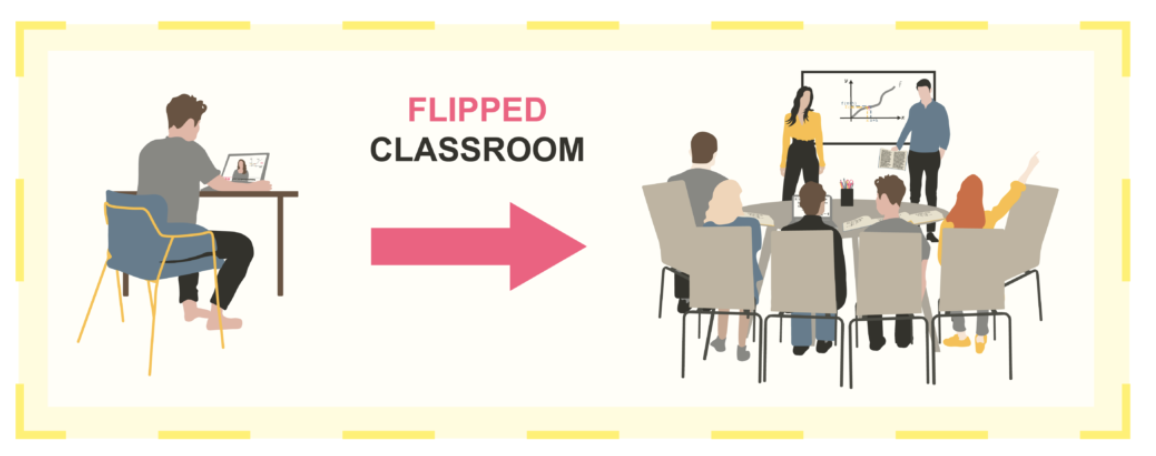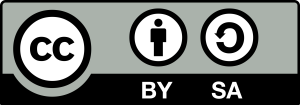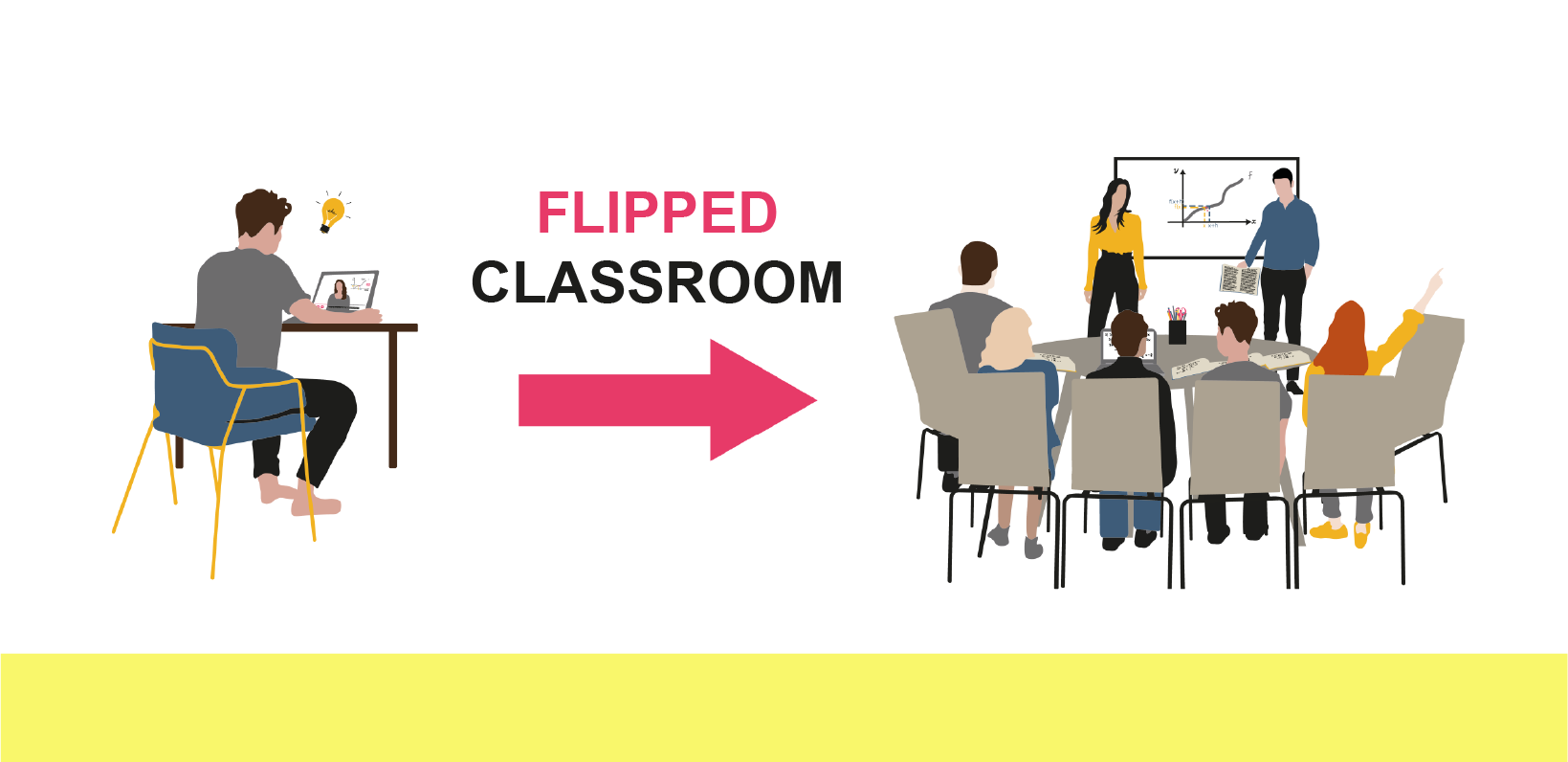#01 - Flipped Classroom
blended learning
"For a long time, I have been wondering why I should ask 200 people to come together to listen to a lecture I had already given a couple of times before. What a waste of time to do that and what a pity not to seize a valuable opportunity! Why should all students gather in a single room to simply listen passively to a lecture? Is being in the same place really necessary to gather and disseminate information? Wouldn't it be better - since we are already together in the same room - to directly interact with one another?" - Christian Spannagel
Basic idea & learning psychology of the concept
Flipped Classroom is a didactic concept from the field of e-learning, more precisely blended learning, because there is an online phase which prepares for an in-class phase. The Flipped Classroom concept focuses on active learning and participation. The reception phase is moved from the lecture hall to the preparation phase (mostly at home) of the students. At home, students work with materials provided by the teacher (e.g. online videos or specialized texts) on the topic of the lecture. In the lecture hall, questions on the material and on the topic are answered, students work on different assignments, experiments or problems and lecturers have the possibility to provide supplementary content. In a way, teaching is ”turned upside down“.
From a learning psychology point of view, a flipped classroom unites all of the three major learning theories: behaviorism, cognitivism and constructivism. The teaching of the future will be faced with a focus on competence orientation, which primarily requires the activation of students. The flipped classroom approach offers an effective solution for teachers to meet the requirements of good teaching and of all learning theories.
An example from the learning theory cognitivism: if teachers provide their students with additional materials and useful links, discovery learning will be encouraged and learners will be able to independently decide which approach to learning works best for them. In addition to that, by using multimedia and diversified materials, various types of learning habits will be equally addressed.

A flipped classrom scenario combines in-class time and modern types of e-learning to create a meaningful learning arrangement.
Reasons and benefits
Why should you "flip" your classroom?
- Students can work at their personal learning pace.
- A flipped classroom encourages interaction between teachers and students.
- There will be more possibilities for self-directed and cooperative learning.
- By using online tools, teachers can be released from the role of lecturer and adopt a coaching role.
- The teacher can monitor the students‘ learning progress and directly react to it.
How can I use the flipped classroom concept in my teaching?
- Identify course contents which can be provided, for example, as videos or in an equivalent form
- Make an appointment with the Educational Technology (LLT) team: discuss the didactic approach and record videos in the studio (or use already existing videos)
- Inform your students about the flipped classroom method and upload the videos to a platform such as TeachCenter or iMooX
- Plan in-class sessions with exercises, additional tasks and engaging activities
- Go to the lecture hall, interact and experience active learning!
Flipped Classroom & Exams
As a teacher, how can I adapt my exams?
There are various examination scenarios for a flipped classroom model. The spectrum ranges from a single summative assessment at the end of the semester to oral formative intermediate examinations to complex grading systems. These differences result from different examination regulations and group sizes.
It is important that the selected evaluation system is in line with the didactic concept of the course.
Option #1:
Bergmann and Sams, the founders of the flipped classroom method, recommend that oral exams be conducted in a formative manner to verify in-depth understanding. Since the teacher is released from the role of the lecturer, the oral exams can also be carried out during the time in class. At the end of the semester, a summative assessment can be conducted and constitutes the second part of the final grade.
Option #2:
Clare A. Francis, a professor in the University of North Dakota, describes an even more differentiated system. The grade for the module is composed of several parts. 10% of the grade is for e-assessments, which have to be completed before each event. There are also bonus points for additional tasks. A summative assessment accounts for 50% of the grade. The rest consists of graded notes, worksheets and the active participation in a project in the lecture. Because of her examination system, students are encouraged to take advantage of the offers from the online and in-class phases. It is not worth it to just work through the videos and e-assessments and not participate in the in-class phase. Refraining from using the resources provided online is also reflected in the grade.
Bibliography
1 Prof. Dr. Christian Spannagel, PH Heidelberg (Landeslehrpreisträger 2012) Christian Spannagel.cspannagel, dunkelmunkel and friends. URL: http://cspannagel.wordpress.com/tag/flipclass/
2 J. Bergmann, A. Sams. (2009). Remixing chemistry class: Two Colorado teachers make vodcasts of their lectures to free up class time for hands-on activities. Learning & Leading with Technology, 36 (4), pp. 22-27.
3 Clare A. Francis. „Student Rates of Outside Preparation before Class Discussion of New Course Topics: A Case Study of a Flipped Classroom“. In: Hrsg. von Jared Keengwe, Grace Onchwari und James N. Oigara. 1. Aufl. Hershey: IGI Global, 2014, S. 269–281.
Licensed under a Creative-Commons License CC BY-SA 4.0
(except icons)

